[This student submission, created for English 100 Composition class, was selected to appear in Ka Hue Anahā student journal, which publishes academic and research writing in all disciplines and programs except STEM-related courses. For inquiries and information about submissions, contact the Board of Student Publications.]
By Parker Hanzawa
Hoʻohōkūlani was inconsolable as she stood holding her stillborn son in her arms. Hoʻohōkūlani’s father Wākea, who was also the father of the infant, comforted her as they decided what to do. Together, they buried their son in the soil behind their house and named him Haloanakalaukapalili. Suddenly, Hoʻohōkūlani and Wākea noticed that a plant began to grow from their son’s grave. This plant was taro. Soon after, Hoʻohōkūlani gave birth to another son, and named him Hāloa, after his elder brother. Hāloa cultivated the taro and took care of the islands of Hawai‘i while Haloanakalaukapalili provided food and nourishment. This reciprocal relationship of brother taking care of brother has endured until this day because Hawaiian people believe that they are direct descendants of Hāloa. The agricultural practice of taro farming that helped sustain Hawaiians culturally and socially can be directly applied to today’s society. This can be done by practicing Hawaiian values and using indigenous agricultural land to grow produce locally, which will help build a sustainable future.
Taro, or Kalo in Hawaiian, is the main staple of the Native Hawaiian diet. According to Cho et al. (2007), taro is believed to be one of the most ancient cultivated crops in the world, with origins tracing back to Southeast Asia. Beginning in 1600-1200 BC, long-distance voyaging canoes were developed and migrating voyagers reached the islands of Fiji, Western Polynesia, and Eastern Polynesia, and brought taro with them. Taro eventually found its way to Hawai‘i around 900 to 1000 AD, which was brought by voyagers from the Marquesas Islands (Cho et al., 2007, p. 1). Over the next millennia, taro cultivation in Hawai‘i turned into a sophisticated and intricate system, which supported a population comparable to today’s population in the islands.
Hawaiians cultivated both wetland and dryland taro, the most common being wetland. This was done in taro terraces, or loʻi’s. Creating and maintaining a loʻi required extensive physical labor. Wetland taro needed a steady source of fresh water, so areas chosen for creating loʻi’s were usually close to a mountain stream. Once an area was chosen for a loʻi, it would be flooded for several days. Then, Hawaiian men would use oʻo, or digging sticks, to dig up the wet mud and create a border or embankment around the area. Leaves and fine soil were then stomped into the sides and floor of the lo`i to make them watertight. Water flowing from the kahawai (river) is slowed by mānowai (loose wall or rocks), which diverts the water into the poʻowai (headwater) and down the ʻauwai (rock lined canal), into the loʻi. The water would then flow through the loʻi, keeping the taro at a suitably cool temperature, and eventually returned to the stream.
Taro was such an essential part of Hawaiian culture that everyone in the community would tend to the loʻi’s. It was at these loʻi’s that men, women, and children worked and connected with the land. While working in loʻi’s, Hawaiians built relationships not only with each other, but with the gods and the world around them. The Hawaiian word ʻohana, meaning family, is derived from the world ʻohā, which were the shoots growing out of the main corm of the taro plant, also known as the makua or parent. Due to taro’s social importance in Hawaiian culture, different types of taro served different purposes. Some were used for ceremonial purposes, others were only eaten by the aliʻi or chiefs, while others served medicinal purposes. Working in loʻi’s taught Hawaiians essential values such as aloha ʻāina (love the land), mālama ʻāina (take care of the land), laulima (working together), and kōkua (to help).
The values that Hawaiians learned while working in loʻi’s were also taught to me. During high school, I took a field trip to the Heʻeia loʻi in Kāneʻohe. I can recall the sun peeking over the staggering cliffs of the Koʻolau mountain range and the Ulumano breeze of Kāneʻohe grazing my face as I began working in the loʻi. As I stepped in, mud instantly engulfed my feet. Walking was difficult as my feet sank deeper with each step. The stench of mud was overwhelming as the heat of the sun struck the loʻi. My class and I worked tirelessly removing weeds the entire day. As the day came to an end and I stepped out of the loʻi, mud crusting my entire body, I remember feeling a sense of gratitude towards my ancestors.
My Hawaiian ancestors understood the significance that agriculture had on the sustainability of the Hawaiian Islands. The Hawaiian cultural saying, “e pili ‘ana āpau,” means everything is connected. Levin (2015) stated, “The soil, the rocks, and everything that grows upon it, the fresh waters that flow…the peaks of the mountains…the life-giving rains…all of the energy moves within as part of a whole system” (p. 87). Hawaiian taro farmers were able to incorporate strategies that preserved and restored the environment, something that is not presently practiced.
However, evidence reported by Kurashima et. al (2019) has shown that Hawaiian agricultural systems used in the past, such as the cultivation of both wetland and dryland taro, can be used today as well. The food produced in these ancient Hawaiian systems can be compared to the total amount of food that Hawai‘i consumes today. For example, the non-indigenous crops that Hawai‘i depends on for modern consumption could be potentially harvested using the same systems that Native Hawaiians used to use. These systems are highly adaptive and recover rapidly following disturbances; therefore, they can increase food production. The use of these lands to produce food will be able to meet consumer demands as well as contribute to a more sustainable future. Kurashima et al. (2019), concluded that “The utilization of former indigenous agricultural lands could provide an approach to produce more local food crops that are culturally appropriate for consumers today” (p.194). Since only 13% of indigenous agricultural land can no longer be used, the remaining 87% can be used for farmers to produce more food locally, reducing Hawaii’s dependence on imported food and reducing our ecological footprint (Kurashima et. al, 2019, p. 194).
For this to happen, the values that Hawaiians learned while working in loʻi’s must be implemented into our society. This is the main reason Hawaiians were able to sustain themselves for thousands of years. Loving the land, taking care of the land, working together and helping are values that aren’t practiced by many today because of society’s need to produce as much as it can, and as fast as it can. Sustainability depends on not only our ability to foster agricultural growth, but our ability to treat the world around us and most importantly, each other, with love and respect.
Hawaiians were able to demonstrate a sense of sustainability thousands of years before it became an issue. Not only did Hawaiians understand the ripple effects agriculture had on society, but also its effect on the natural world around them. Since Hawaiians traced their lineage to Hāloa, a sense of self was mirrored in the very food they cultivated and consumed, which transformed the way Hawaiians perceived nature. For Hawai‘i have a more sustainable future, a change must be made, which can be modeled after the past. Aʻohe hana nui ka alu`ia—no task is too big when done together.
References
Cho, J. J., Yamakawa, R.A., & Hollyer, J. (2007). Hawaiian Kalo, Past and Future. Sustainable Agriculture, 1 (SA-1), 1-8. https:// scholarspace.manoa.hawaii.edu/bitstream/10125/12594/SA-1.pdf
Levin, P. (2015). Thinking Like an Island: Navigating a Sustainable Future in Hawai‘i. University of Hawai‘i Press.
Kurashima, N., Fortini, L., & Ticktin, T. (2019). The Potential of Indigenous Agricultural Food Production Under Climate Change in Hawai`i. Nature Sustainability, 2(3), 194.






